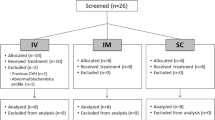Abstract
A cluster of bleeding complications in previously healthy women operated on for macromastia by reduction mammaplasty prompted a retrospective study of 293 patients treated during 1991–1992. Nine out of ten patients with profuse intraoperative bleeding had received the NSAID diclofenac (Voltaren™) as part of premedication. Eight out of 20 postoperative haematomas were noted in patients treated with the NSAIDs diclofenac (Voltaren™) or ketorolac (Toradol™) for postoperative analgesia. These findings indicate that NSAID treatment increases the risk of intra- and postoperative bleeding complications in certain patients operated on for macromastia by reduction mammaplasty.
Similar content being viewed by others
References
Strömbeck JO (1991) Reduction mammaplasty with horizontal pedicle techniques. In: Plastic and reconstructive surgery of the breast. Decker, Philadelphia, p 195
Skoog TA (1963) A technique of breast reduction. Acta Chir Scand 126:453
Hugo NE, McClellan RM (1979) Reduction mammaplasty with a single superiorly based pedicle. Plast Reconstr Surg 63:230
Holmström H, Lossing C (1990) Reduction mammaplasty with a sliding nipple technique. Scand J Plast Reconstr Surg Hand Surg 24:245
McKissock PK (1972) Reduction mammaplasty with a vertical dermal flap. Plast Reconstr Surg 49:245
Toradol™ (ketorolac tromethamine) — monograph (1991) Syntex
Spowart K, Greer IA, McLaren M, Lloyd J, Bullingham RES, Forbes CD (1988) Haemostatic effects of ketorolac with and without concomitant heparin in normal volunteers. Throm Haemostas 60:382
Power I, Chambers WA, Greer IA, Ramage D, Struan E (1990) Platelet function after intramuscular ketorolac. Anaesthesia 45:916
Garcha IS, Bostwick J (1991) Postoperative hematomas associated with Toradol. Plast Reconstr Surg 88:919
Dowback G (1992) Personal experiences with toradol. Plast Reconstr Surg 89:183
O'Leary M, Martin P, McLean AS (1993) Oliguria and haemorrhage after intramuscular injection of ketorolac trometamol. Med J Aust 158:719
Information from the Swedish Drug Administration (Läkemedelsverket) (1993) Toradol(ketorolac) — choose the right patient (Swedish) p 208
Rorarius MGF, Baer GA, Siirtola M, Lahti T, Laippala P (1993) Effect of intravenous diclofenac or indomethacin on the emergence from anaesthesia for tonsillectomy. Acta Anaesth Scand 37:616
Pertunen K, Kalso E, Heinonen J, Salo J (1992) I.v. diclofenac in postthoracotomy pain. Br J Anaesth 68:474
Schulman S (1991) DDAVP — the multipotent drug in patients with coagulopathies. Transf Med Rev 5:132
Mannucci PM, Lusher J (1989) Desmopressin and thrombosis. Lancet II:675
Lethagen S, Rugarn P, Bergqvist D (1991) Blood loss and safety with desmopressin or placebo during aorto-iliac graft surgery. Eur J Vasc Surg 5:173
Author information
Authors and Affiliations
Additional information
The Department of Plastic Surgery was formerly (until 30 June 1994) located at the Sabbatsbergs Hospital, Stockholm Correspondence to: L. Blomqvist
Rights and permissions
About this article
Cite this article
Blomqvist, L., Sellman, G. & Strömbeck, J.O. NSAID as pre- and postoperative medication —a potential risk for bleeding complications in reduction mammaplasty. Eur J Plast Surg 19, 26–28 (1996). https://doi.org/10.1007/BF00209787
Issue Date:
DOI: https://doi.org/10.1007/BF00209787




